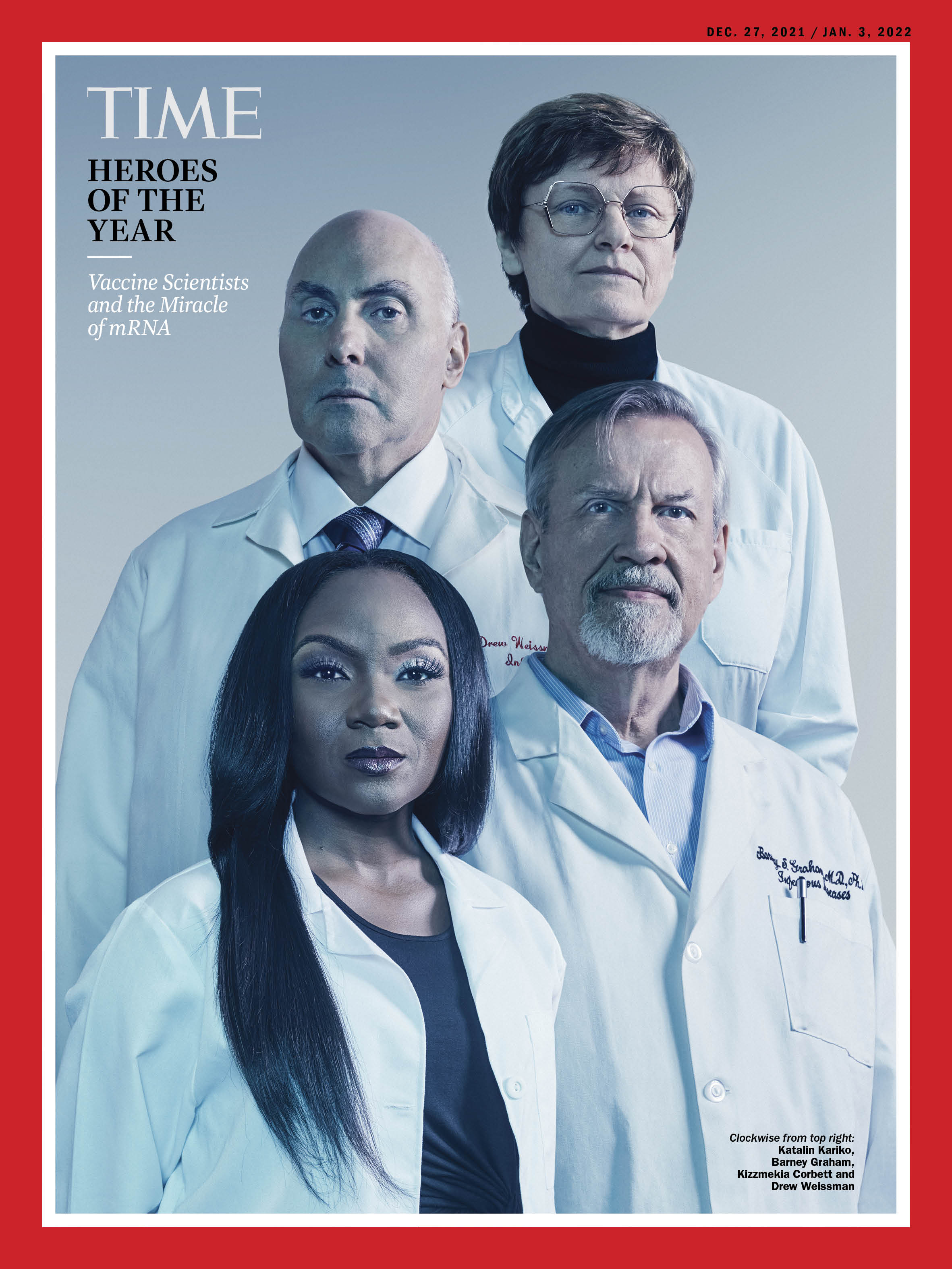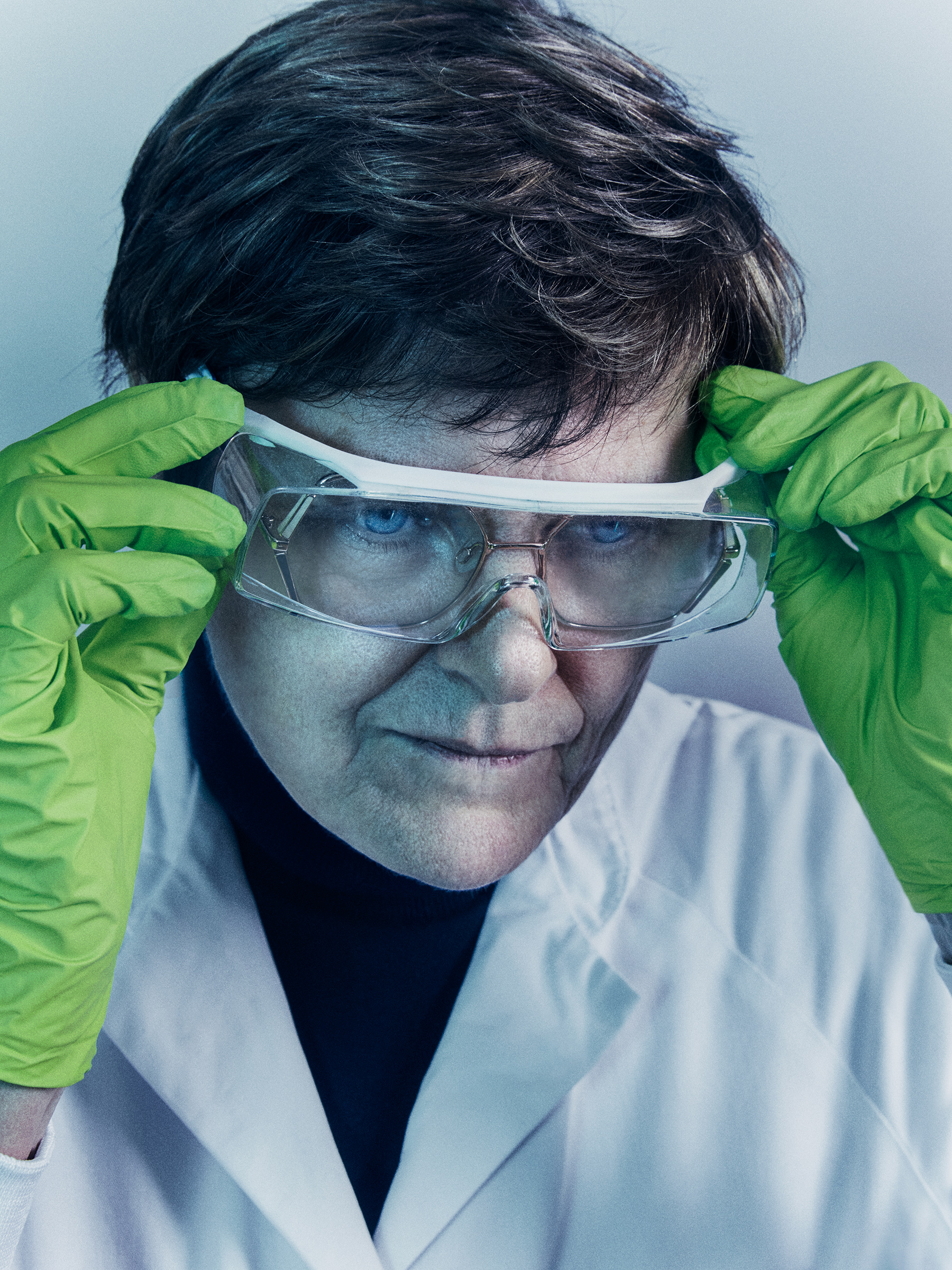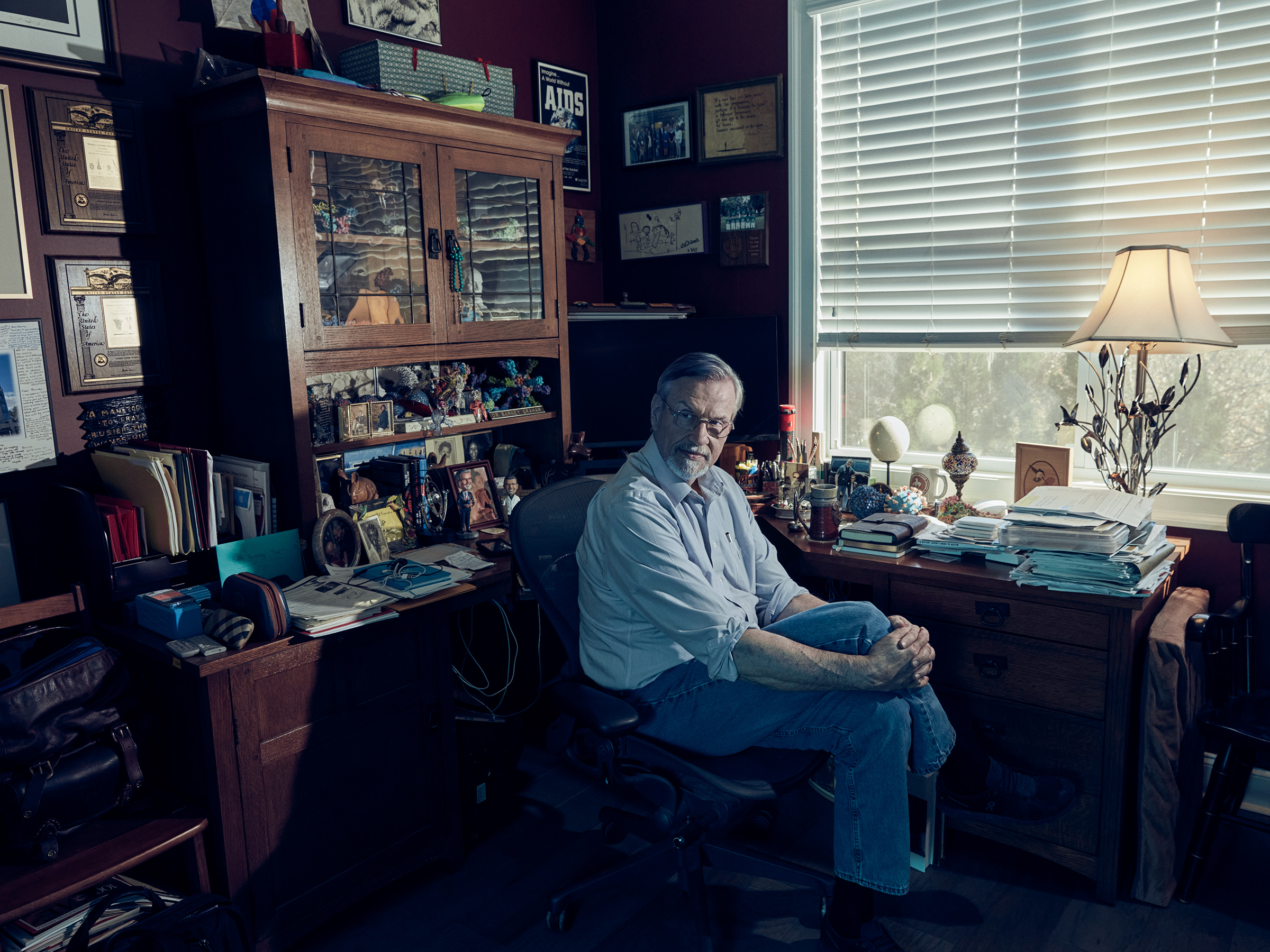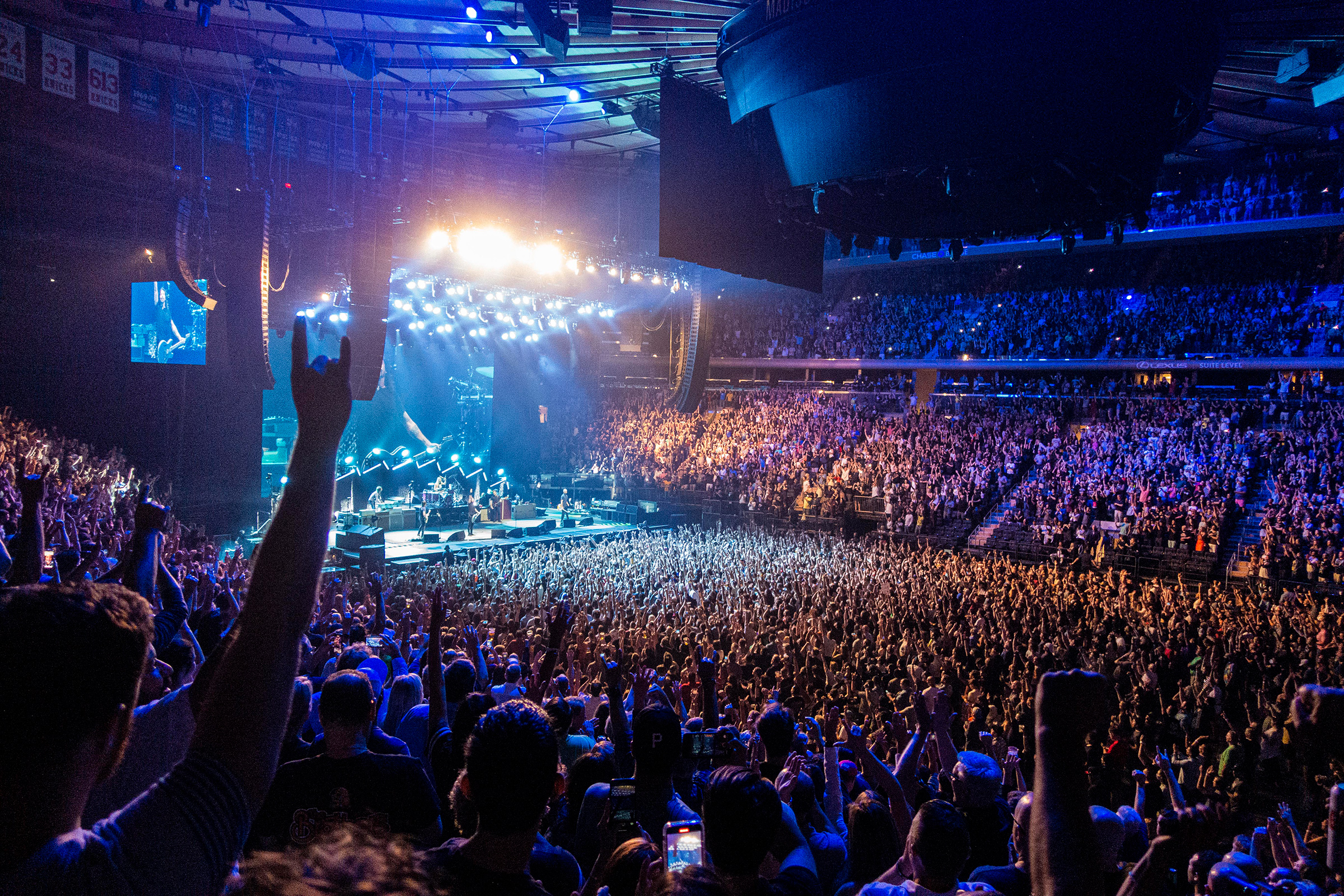No one knows for sure where the virus came from. It could have been the murky depths of one of the hundreds of bat caves scattered across China. Carried inside a bat on a nightly sojourn, the virus may have jumped to another wild animal, perhaps one of those sold in the wet markets in the region. It’s also possible SARS-CoV-2, the virus that causes COVID-19, slipped out of a lab at the Wuhan Institute of Virology, unbeknownst to the researchers studying bat-borne coronaviruses, who were perhaps unintentionally infected by the very thing they were trying to learn how to defend against. In either case, it had to ride in something. A virus, being just a bundle of genetic material wrapped in a bundle of proteins, needs the machinery of a living thing to reproduce. It’s in the dark caverns of bodies that it continues to shift shape, finding new ways to spread and thrive.
Only as the virus emerges from the shadows of these favored havens does it confront its most formidable foe: the scientists quietly awaiting it. How they responded was less mysterious, and certainly less unpredictable, than the virus they targeted. Their medium was light, and the brightness of scientific truth, which they painstakingly pursued in brilliantly lit research labs and “clean rooms” scrubbed of airborne particles—and produced brilliant results.
About a month after the first cluster of patients appeared wheezing in a Wuhan hospital, the entire genome of the responsible coronavirus—30,000 specific nucleotides—had been sorted, identified and posted online.
Two weeks later, designs were already being keyed into machines to create a vaccine that would unlock a world that had not even locked down yet.
Given that speed, it was easy to imagine that a solution to the problem of SARS-CoV-2 was inevitable. After all, things we took to be miracles not long ago have become the stuff of everyday life—routine, apparently effortless. A miracle is as close at hand as your average smartphone, which has 100,000 times the computational power as the computer that took humankind to the moon. In 2020, if scientists in China were able to map the genetic structure of a novel virus in a few days, that sounded, well, about right. Later, as countries went into lockdown, we continued to assume progress, to regard vaccines as our due.
Except there was nothing inevitable about them. The vaccines that first arrested the spread of COVID-19—and that will almost surely be adjusted to thwart the Omicron variant and future mutations—were never a foregone conclusion. Far from it. They were, after all, produced by human beings, subject to the vagaries of systems and doubt. There were times in their careers when, deep in the work that would ultimately rescue humanity, Kizzmekia Corbett, Barney Graham, Katalin Kariko and Drew Weissman felt as though the problems they faced were ones they alone cared about solving. But exposing the inner workings of how viruses survive and thrive is what made the COVID-19 vaccines possible.

The four were hardly alone in those efforts: scientists around the world have produced COVID-19 vaccines using a variety of platforms and technologies. Many—like the shots from Oxford-AstraZeneca and Johnson & Johnson–Janssen—came from more established methods, modified with impressive speed to fight a new virus. Still, Corbett, Graham, Kariko and Weissman achieved a breakthrough of singular importance, introducing an innovative and highly effective vaccine platform, based on mRNA, that will impact our health and well-being far beyond this pandemic.
Progress flows from the gradual accretion of knowledge. In the case of the COVID-19 vaccines, it started with the initially painstaking process of decoding the genomes of all living things; then folded in the development of sequencing machines that reduced that genetic reading time to hours; and finally weaved in the insights—“Put it in a fat bubble!”—that seemed to come in brilliant flashes but were actually the result of wisdom developed over decades working on how to manipulate a finicky genetic material called mRNA. What drives it all might, in less divisive times, seem too obvious to mention: fealty to facts. It’s the basis of the scientific method and the structure of our world. Without trust in objective reality, the lights don’t turn on, the computer doesn’t boot up, the streets stay empty.
“We have turned a disease that has been a once-in-a-generation fatal pandemic, that has claimed more than 780,000 lives in America, into what is for the most part a vaccine-preventable disease,” says Dr. Leana Wen, professor of health policy and management at George Washington University. “That is the difference that the vaccine has made.”
For those of us lucky enough to live in wealthy countries with access to these top-shelf vaccines, it has made all the difference. The miracle workers behind the COVID-19 vaccines are the TIME Heroes of the Year not only because they gave the world a defense against a pathogen, but also because the manner of that astonishing achievement guards more than our health: they channeled their ambitions to the common good, talked to one another and trusted in facts.
Katalin Kariko grew up the daughter of a butcher in a small town in Hungary, living under Communist rule in the 1950s and ’60s. The family had electricity, but not running water or a refrigerator. Watching her father at his job, the young Kariko became fascinated with figuring out how living things work. That took her to undergraduate studies in biology at the University of Szeged, where she first learned about RNA. It would become her obsession through her biochemistry Ph.D. studies, postgraduate work and, really, the rest of her life. If DNA makes up the letters of life, RNA creates the words, and ultimately the sentences. Indeed, RNA, and specifically messenger RNA, or mRNA, instructs the body how to make all the proteins, enzymes, receptors and other molecules that enable living things to function. As a Ph.D. -student, Kariko grew convinced that mRNA, modified in the right way, could be used to turn the body into its own drug-making factory, and churn out tailored, precision compounds to treat any disease caused by a lack of a certain protein, which could be an enzyme or a hormone.

The challenge with mRNA is that it’s notoriously unstable: inject it into the human body, and it gets chewed up before it can serve its purpose. It is also difficult to work with, since it needs to be stored at extremely low temperatures to remain intact. After a few years of frustrating work at the Biological Research Centre at Szeged with no success in corralling mRNA, Kariko lost funding to her lab.
To continue her work, in 1985 she found a position at Temple University in Philadelphia but faced a new obstacle: to discourage defection, the Hungarian government limited citizens to taking only $50 with them when they left the country. Kariko and her husband sold their car for $1,200 and sewed the cash inside their 2-year-old daughter Susan’s teddy bear.
Kariko moved to the University of Pennsylvania in 1989. Few others at Penn or elsewhere were pursuing mRNA at the time, because its payoff seemed uncertain. But Kariko persevered, envisioning a bonanza of new treatments for heart disease, stroke and other conditions. She worked late nights and early mornings at her Penn lab and wrote at least one new grant application every month—only to get turned down again and again. “I think I was rejected at least 24 times,” she says, “but I kept pushing, because every time, I wanted to understand why they rejected it and how could I improve.”
After six years, her supervisors at Penn grew weary of a lack of results and demoted her, cutting off her research funding and control of a lab. Undeterred, she moved to the neurosurgery department for a salary and lab space to continue her research.
Things finally changed for Kariko in 1997, thanks to a casual office conversation by the copy machine. An immunologist and physician named Drew Weissman had just joined Penn to start a lab focused on developing a vaccine against HIV and other diseases. He and Kariko shared a habit of photocopying articles out of recent scientific journals from the research library. By the machine, they discussed their respective approaches to vaccine development. Kariko tried to convince Weissman of the still unappreciated merits of the synthetic RNA she was making. “I’m open to anything,” says Weissman, and so he decided to give it a shot.

Kariko’s problem was that she hadn’t found a way to tamp down RNA’s tendency to trigger the immune system’s inflammatory response, which destroyed the RNA. Over nearly the next decade, Kariko and Weissman combined efforts, and eventually made a breakthrough: changing a specific mRNA building block helped the molecule evade the immune system. Building on that, Weissman figured out that encasing the mRNA in a fat bubble protected the precious genetic code when it was introduced to the body of a living thing, while at the same time triggering the immune system to target it—which is what a vaccine needs to do.
After that, their research sped up rapidly. For disease after disease—more than 20 in all, including norovirus, influenza, HIV, hepatitis and Zika—the mRNA-based vaccines the duo developed during the 2000s were nearly 100% effective in protecting lab animals from getting infected and sick.
The beauty of the platform lay in its flexibility. Influenza vaccines, for example, take months to develop because most require growing the virus in chicken eggs. An mRNA vaccine requires only a readout of a virus’s genetic sequence. Scientists can take that code, pick out the relevant parts of the genome, build the corresponding mRNA with chemical compounds, pop it into the fat bubble and—presto!—a new vaccine is born.
In 2005, Kariko and Weissman reported their findings in what they thought would be a landmark paper in the journal Immunity, then waited for the accolades to flood in. “I told Kati the night before the paper was published, Tomorrow our phones are going to ring off the hook,” says Weissman. No one called.
It would take another 15 years—and the emergence of the devastating SARS-CoV-2 virus—before the global science community would finally grasp the importance of their discoveries. In the meantime, some scientists were gradually starting to build the case for the promise of mRNA, including Ugur Sahin and Ozlem Tureci, co-founders of a German company called BioNTech. In 2013, Kariko joined the company to head its mRNA program, focused at the time on cancer vaccines. In January 2020, Chinese researchers published the genetic sequence of the new coronavirus causing COVID-19. BioNTech quickly pivoted toward working on a vaccine for the novel coronavirus, eventually partnering with pharmaceutical giant Pfizer. By then, the groundbreaking nature of the technology Kariko and Weissman had pioneered finally had the attention of scientists worldwide, who realized that the plug-and-play model meant potentially lifesaving shots could be developed—and, more important, delivered—in record time.
The duo had created the perfect vehicle for targeting any virus or pathogen. But making a truly effective vaccine—one that could also efficiently stir a powerful immune response inside the body—would require another step.

The faint drawl and easygoing nature of Kansas native Dr. Barney Graham can hide an intensity of devotion and singularity of purpose, qualities that Dr. Anthony Fauci back in 1997 felt made Graham the perfect deputy director of the newly created Vaccine Research Center (VRC) of the U.S. National Institute of Allergy and Infectious Diseases. Vaccines appealed to Graham’s MacGyver tendencies; as a child, he loved to troubleshoot broken-down equipment on the family farm. In the intervening years, those problem-solving interests migrated to HIV and respiratory syncytial virus (RSV). Graham was working on a vaccine for RSV, a coldlike contagion, when a new target, SARS-CoV-2, emerged.
Over the decades leading to the pandemic, one approach in particular had captured his scientific curiosity: “structure-based design”—essentially, constructing a vaccine based on the shape of the virus’s proteins. It sounds intuitive enough, but at the time wasn’t technologically feasible.
It would take Graham 25 years to solve that problem. It turns out the configuration that a key RSV protein takes on just before it fuses with a healthy cell looks drastically different from the form it takes after infection. The latter was where most vaccine efforts had been focused up to that point, in part because it’s only in that pre-fusion shape for a very short time, as it reconfigures itself constantly to evade the most potent antibodies. But a more effective vaccine would target the virus before it attached. By 2012, Graham and a postdoctoral fellow had figured out a way to stabilize that ephemeral formation long enough to attract the right immune cells. That revelation would turn out to be foundational because other viruses also adopt a similar pre-fusion form. “They’re on many of the envelope proteins that we study, like HIV, influenza paramyxoviruses and Ebola,” he says. “And they’re also on coronaviruses.”
In 2014, to put the discoveries of Graham’s team to the test, the VRC began collaborating with Moderna, a small biotech company based in Massachusetts. (Like BioNTech, Moderna was working on making mRNA vaccines a reality, though focused on infectious diseases instead of cancer.) In July 2019, Graham and his team published early results showing that a vaccine built on Moderna’s mRNA platform and containing their modified RSV protein boosted the immune response in people by more than tenfold over previous RSV vaccines.

In the meantime, Kizzmekia Corbett, a Ph.D. graduate in microbiology and immunology from the University of North Carolina at Chapel Hill, joined Graham’s team, and had begun work applying what the group had learned about RSV to coronaviruses. By 2019, she and her colleagues had figured out how to design what’s known as the spike protein, the part of the virus that attaches to the healthy cell, in such a way that the immune system could mount a maximal response. It was, essentially, advance work for the coming pandemic.
When the first reports of the new coronavirus emerged from China, Graham and Corbett were confident the technique would work on it, says Corbett: “All of that knowledge culminated to the point where we said, ‘O.K., we know how to design a really good vaccine, because we’ve been doing this for six years.’” All they needed was the genetic code for SARS-CoV-2.
Based on his success with freeze-framing the right viral structure of other viruses, Graham figured that stabilizing the SARS-CoV-2 spike protein at its similar state just before infecting a cell would have the same immune-activating effect in a vaccine. “We had done it with a dozen other coronaviruses and it worked every time,” he says. “I was anxious to get the sequence for SARS-CoV-2.” On Jan. 9, 2020, he emailed the director of the Chinese Centers for Disease Control, requesting the genomic data, then went to see Fauci. “He came into the room on the 7th floor,” says Fauci, “and in his typical Southern drawl said, ‘I just need the sequence. I’m telling you I think we can do this.’”
On Jan. 10, Chinese scientists published the sequence of the new virus, and the team got to work. “Dr. Graham and I had discussed exactly how we would maneuver in that moment, so once the sequence came out, we knew exactly what we would do,” says Corbett. “We knew where to make the mutations in the spike protein [to stabilize it] and we knew the type of platform we would like to make the vaccine with, which was the mRNA platform with Moderna. So we really had a plan.”
Graham’s insight—to target the pre-fusion spike protein—became the basis for several of the major vaccines being tested or used around the world now, including the ones from Pfizer-BioNTech-, Moderna, Johnson & Johnson–Janssen, Sanofi and Novavax. Corbett predicts that it will also help humanity defend against other viruses that may emerge in coming years. “If we as scientists learn how to make a vaccine for a cousin in a viral family, and one of those cousins decides to make a pandemic,” she says, “then we’ll be ready, because we can apply the knowledge from one virus and vaccine to another in a plug-and-play way.”
After decades of largely unsung research, Corbett, Graham, Kariko and Weissman didn’t have to wait long to see the results of their work on COVID-19 vaccines. On Nov. 8, 2020, Fauci received a call from Pfizer CEO Albert Bourla. “Are you sitting down?” he asked Fauci. “Because you’re not going to believe the results. They’re unbelievable, over 90% efficacy.”
Graham’s son and grandchildren were visiting when the news reached him. “We pretty much had a group hug and then I went back to work,” he says. “After those 10 months of working all the time … and trying to get to an end point, just the relief to know that we had something that might make a difference was the thing that was most meaningful to me.”
Kariko was celebrating her daughter’s birthday with her husband when she got the call from Sahin, BioNTech’s CEO. He asked if she was alone, so she walked to another room, then celebrated in the same understated way that characterized her entire scientific career—with her favorite treat, a box of Goobers.
Weissman and Kariko got their first doses of the vaccine they helped develop on Dec. 18, 2020, and just before Christmas, Graham and Corbett got their first shots. “Most scientists never get to see their product actually used,” says Graham. “To watch the evening news and see the relief from health care providers who were getting immunized, to see people in the clinic at NIH being vaccinated and being so relieved and so grateful—those were special moments.”
The fastest any earlier vaccine had been developed was four years (for mumps, in the 1960s). The shots developed by Pfizer-BioNTech and Moderna took less than 12 months. That made some skeptical: Could one trust a brand-new technology, -engineered in record time to fight a -brand-new virus?
That question, however, overlooks the years of work scientists had put into perfecting an mRNA platform. “Without [decades of] basic research, those vaccines would not have been possible,” says Dr. Stanley Plotkin, a veteran vaccinologist who invented the rubella vaccine. “When the epidemic broke out, the technology was available.”

Corbett admits that scientists themselves could have better communicated that fact. “Sometimes I regret the way that we announced that we could have a vaccine,” she says. “Because it came without the understanding of all the work that we had done before. While we did design a vaccine basically overnight, and move quickly into clinical trials, there was so much confidence in the way we did that because we’d been preparing for years.”
It was hardly the first miracle of science to defy belief. A year after the Apollo 11 lunar landing, 30% of Americans surveyed said they did not believe humans had actually walked on the moon. And that was long before social media, the rise of the antivax movement and the many other recent crises of truth that have created barriers to the successful rollout of the vaccines. In the U.S., tens of millions of people refuse to get the shots that are available almost everywhere.

Globally, vaccine hesitancy has combined with inequality and lack of access to create a disastrous state of affairs in poorer parts of the world. COVAX, the multinational program designed to distribute vaccines to low-income countries, is only about a quarter of the way to its original goal of distributing 2 billion doses by the end of 2021. Some of that can be chalked up to wealthier countries hoarding doses, but there are other problems. In some parts of the world, when doses arrive, health workers must overcome significant logistical challenges to get them from airport tarmac to people in hard-to-reach places, and doubts about vaccine safety and efficacy have proved a global phenomenon. That mix of challenges has created severe vaccine inequality, such that only 30% of India is completely protected, and not even 10% of people in Africa have been fully vaccinated. As long as that’s the case, the virus will continue to mutate, giving rise to new variants as it spreads almost unchecked.
That doesn’t mean the virus wins. The plug-and-play feature of the mRNA vaccines makes it possible to update them within months to target new variants, be it Omicron or whatever form the virus takes next. The virus moves fast, but scientists have created weapons just as nimble. Even the historically fast development of COVID-19 vaccines may seem slow in the future, now that mRNA platforms have been pressure-tested and fine-tuned.
“A renaissance in vaccinology” is what University of Pittsburgh Center for Vaccine Research director Paul Duprex calls the tools crafted by Kariko, Weissman, Graham and Corbett and the many scientists who collaborated with them over the years. They represent a novel path out of this pandemic, but also a new approach to quelling future ones. Already, vaccine makers are testing mRNA-based vaccines against influenza, potentially making them more effective, safer and easier to produce.
Thanks to the scientists leading the groundbreaking development and elegant construction of these COVID-19 vaccines, we now have a list of near-infinite possibilities. The vaccines work with a magnificence that only highlights how far science has come—and how far behind society remains in recognizing and accepting what is now possible. Our communications, our politics, our splintered cultures are still snarled in confusion and skepticism, keeping people from getting the shots. Through the harrowing first winter of COVID-19, scientists gifted humanity with the ultimate prize—a weapon to fight the pandemic. It’s now up to humanity to return the favor. —With reporting by Leslie Dickstein and Julia Zorthian